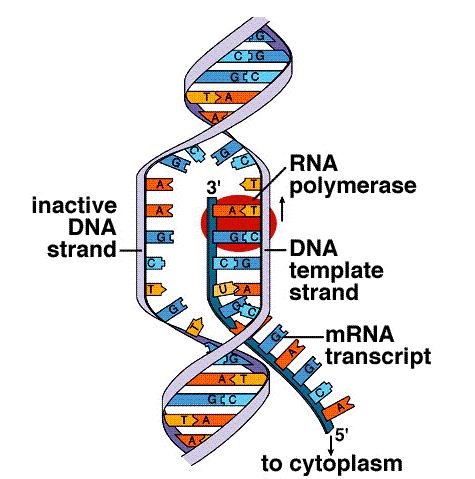Transcription
The first stage of converting the primary genetic information from the stable DNA code into protein is to transcribe the DNA into messenger RNA (mRNA). This process is carried out through RNA polymerase that has several common features with the DNA polymerases. The structure of the RNA polymerase is a little same to the DNA polymerases in the active site region, and also requires Mg2+ to function and synthesizes nucleic acid in a 5’ to 3’ direction. However the RNA polymerases do not require a primer to initiate synthesis. Instead their signal for the initiation of transcription is a specific sequence on the DNA known as the promoter region.

Figure: Transcription
A gene’s promoter is said to be upstream, in that the promoter region is situated to the 5’ end of the coding region. The promoter region allows the RNA polymerase to bind and starts transcription so that the resulting mRNA contains not only the coding region itself but also all the signals to start and stop the synthesis of the polypeptide. How RNA polymerase works is intrinsic to the concept that one gene makes one polypeptide. In eukaryotes genes are arranged so that the promoter region is in such a position that when transcription occurs a single mRNA molecule is produced which can be used to code for a single polypeptide. Genes that code for polypeptides that have a common purpose such as the manufacture of a multi-polypeptide protein are placed in several different parts of the genome frequently on different chromosomes. In prokaryotes both the Archaea and the Bacteria genes are more likely to be arranged so that the coding regions for enzymes involved in a single pathway are clustered together. Further- more several genes may be arranged so close to one another that they are transcribed from a single promoter in Figure. This polycistronic arrangement is called an operon.